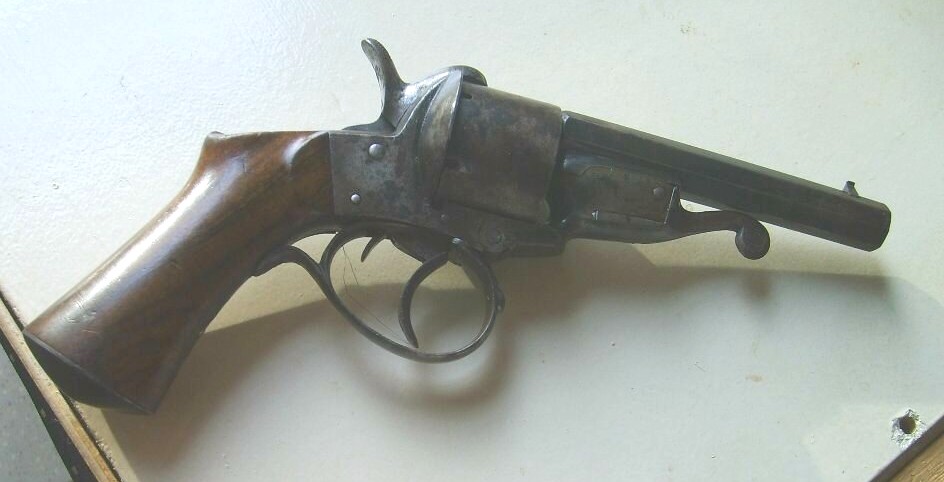
THE JAVELLE REVOLVER
Our webmaster shows me proudly a nice French Javelle revolver he has come across recently. I had already seen some examples of that interesting gun, but I never had the opportunity to examine one closely so far.


Pics 1 and 2
Intrigued by the curious system featuring some kind of a double trigger and a half-cocked position to the hammer, which at least can be called unusual on a double-action revolver, I told him I would be highly interested in disassembling the gun - though it is in excellent condition and does not need any repair - just to see and understand how the inner mechanism works.
Bold as he is, he gave me the gun for examination.
FIRST GLANCE
Its knuckled square-shaped grip gives the revolver the general shape of the Perrin, Lefaucheux 2nd type and RaphaŽl revolvers issued in the 1860's. Created and patented in 1861 by M. Javelle, gunsmith at St Etienne, France, the revolver was manufactured until 1880 in the 9 and 12 mm calibers, first pinfire, and later central fire ammunition. According to some American authors, a small number of the 12 mm caliber saw service during the American Civil War.
If so, I guess we are talking about a very small number found on the European market by the Confederate Major Caleb Huse, or about a few specimens bought at own expenses by soldiers of both sides on US soil. The Javelle revolver has no noticeable military history.
Our specimen is plain and retains a large percentage of that magnificent charcoal blue which is never found on any modern gun anymore, and a one-piece grip made of selected walnut.
It is a 9 mm pinfire six-shooter with full octagonal barrel and rounded trigger guard. The 12 mm ones feature a round barrel with an octagonal rear portion, and a scrolly triggerguard.
On the side of the cylinder I find the St Etienne proofstamp used from 1869 o 1879: a large E between two crossed palms, with an S and an E on the sides and a cross at the bottom. That proofstamp enables us to situate the manufacture of the gun during that decade.
The bottom of the frame, ahead of the trigger guard, shows the mention "JAVELLE.M ST ETIENNE" in a half moon, and also "Btť S.G.D.G" horizontally at the bottom. There are no other marks whatsoever.
The very first remarkable thing on this nice revolver, apart from its nice finish and perfect adjustments, is the topbreak barrel featuring some kind of a claw that is kept closed around the end of the cylinder arbour by a lever located under the barrel and similar to that of the Lefaucheux pistols and shotguns.
When the lever is turned at right angle to the right, the barrel lug opens horizontally into two parts, allowing release of the cylinder arbor and pushing the barrel down, so that the cylinder can be taken out for loading/unloading purposes. The inner part of the lug and the fore end of the cylinder arbor feature a number of ribs that engage each other, keeping the gun perfectly closed and eliminating any play under the pressure of the lever.
Notwhitstanding the fact that the cylinder has to be taken out the gun for loading prevents any accident, it is a long and complicated procedure, that will close all doors to Army or Navy contracts for this nice gun. Consequently, even the larger calibers will have to find their way on the civilian market.
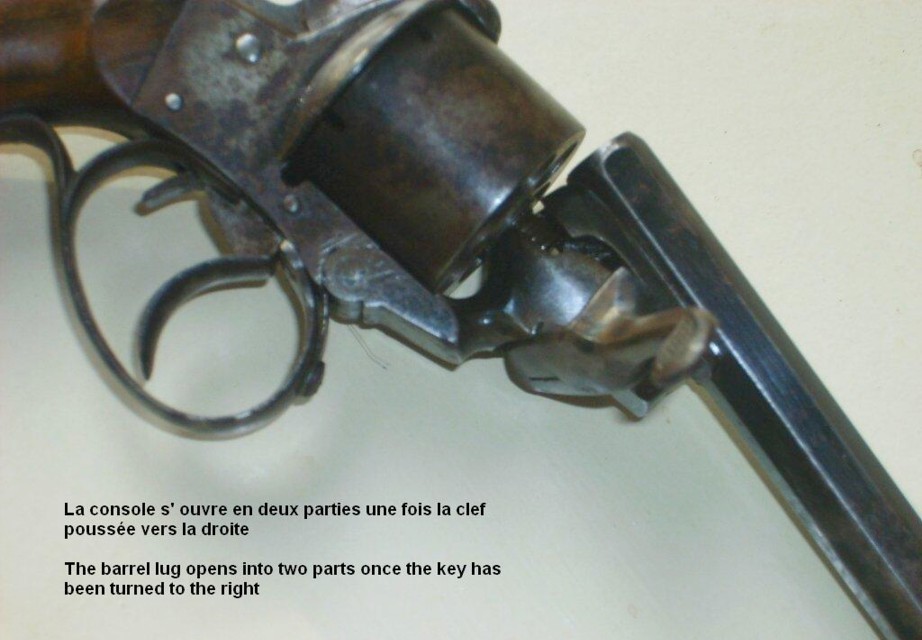
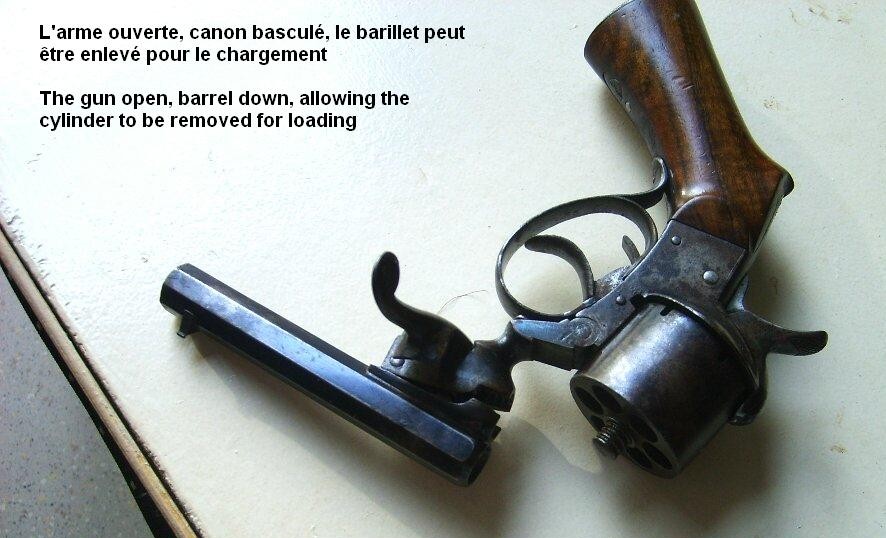
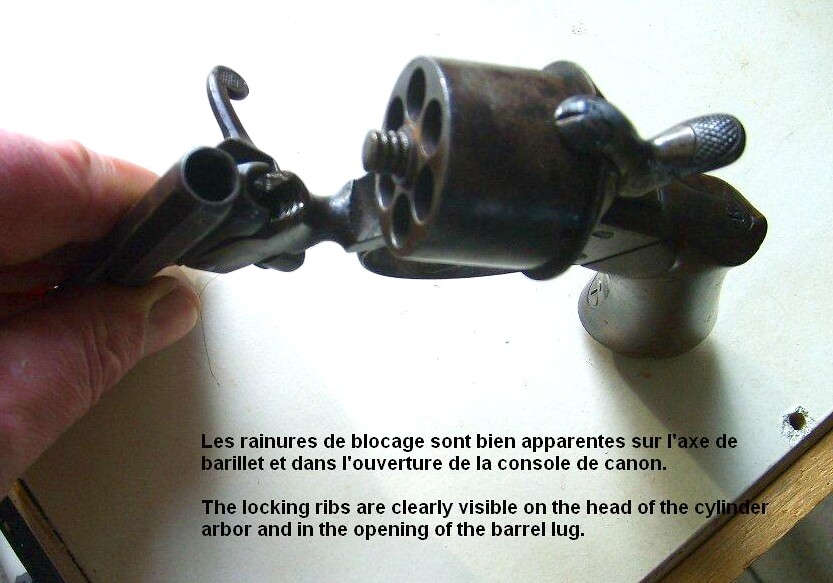
Pictures 3 to 5
The second oddity is the small lever located in the trigger guard behind the trigger, that looks like a second trigger of smaller size (see photo 1). That lever is actuated by the trigger when it is squeezed all the way, and apparently releases the hammer from the fullcock notch.
Last but not least, there is a curious flat spring attached to the front face of the guard, of which the upper end enters the bottom of the frame. At first I have no idea about the function of that spring. If it is a spring.
The cylinder has no apparent locking notches.
DISASSEMBLING
Disassembling starts with the removal of the one-piece walnut grip, which is attached to the frame by two wood screws, the one at the bottom of the forestrap, the other entering vertically through the knuckle? I notice that, like on the Adams revolvers, the knuckle consists in a separate part that surrounds the hammer. The grip has a steel butt, attached on this specimen by a central screw.
Once the grip removed, I can see the main spring, which is a simple flat spring with a fork at the upper part to engage the hammer chain, and attached at the bottom part to the forestrap by a transverse screw.
Under that spring is a second one, flat and curvy, quite shorter and also attached to the forestrap by a transverse screw. Pictures 6 and 6a show the mounting of both springs. The screw that holds the shortest one also holds the rear part of the trigger guard attached to the frame.
Once both spring removed, I can unscrew the hammer axis, which allows removal of the hammer and the knuckle. The latter has on its underside a ring through which the hammer axis passes, holding these parts firmly together.
Then I unscrew the axis to the rear trigger, which falls at one out of the frame.
Prior to disassemble the trigger, I have to remove the guard which is attached in its forepart to the frame by two small screws placed one on each side of the trigger. The guard comes easily, together with its curious flat spring...which appears to be the actual trigger return spring!
Once its screw has been loosen, the trigger comes easily out of the frame, together with the pawl.
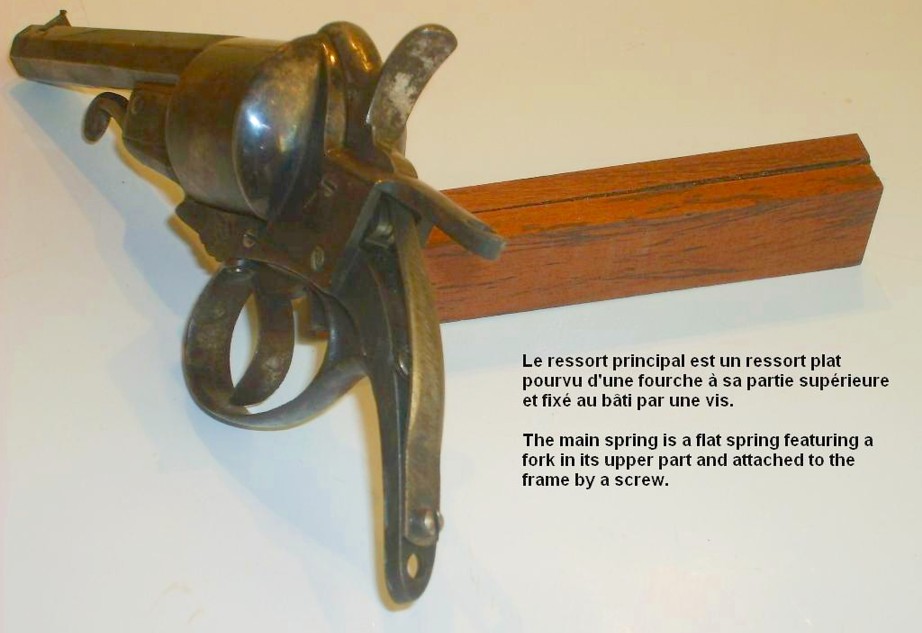
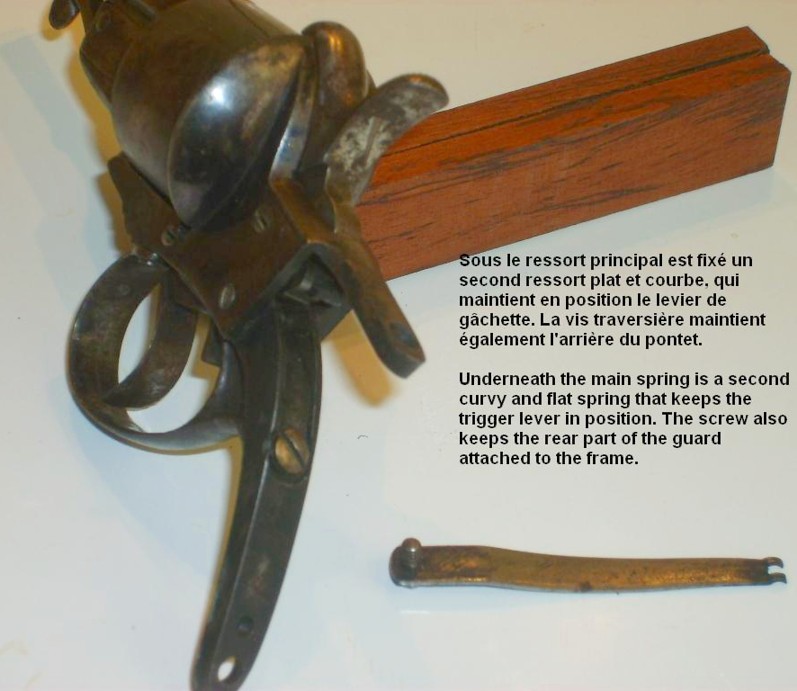
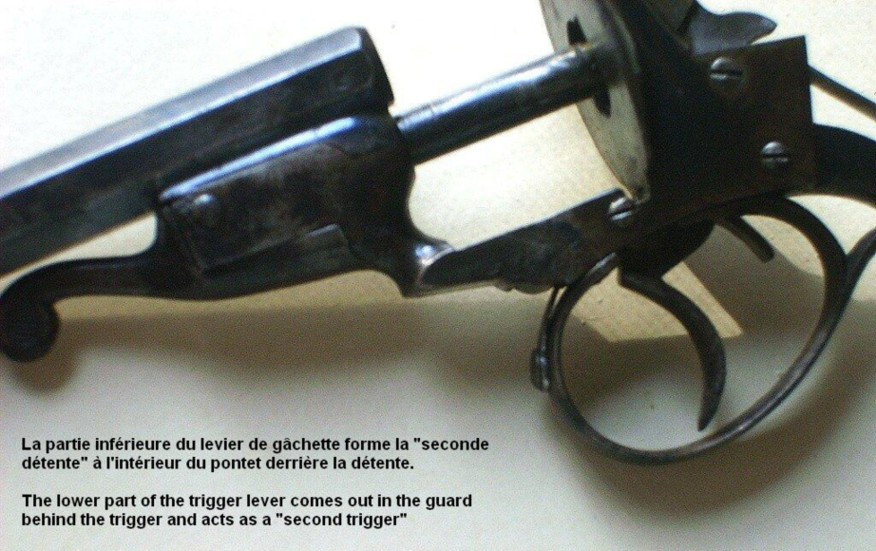
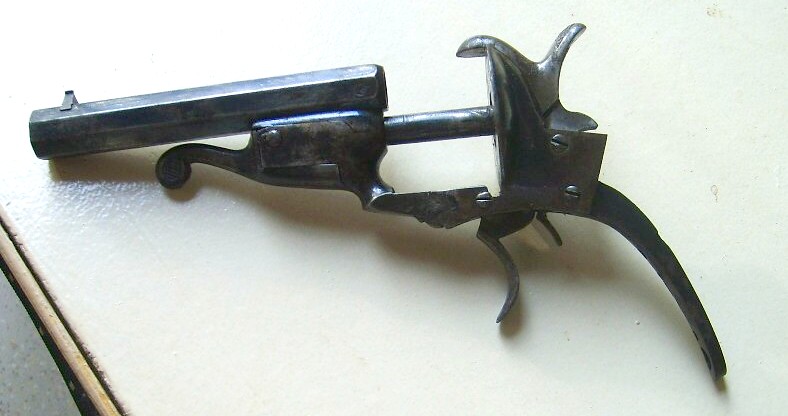
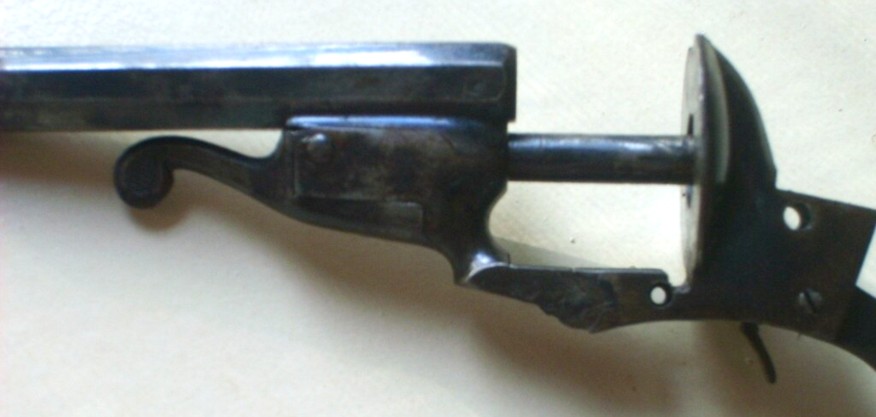
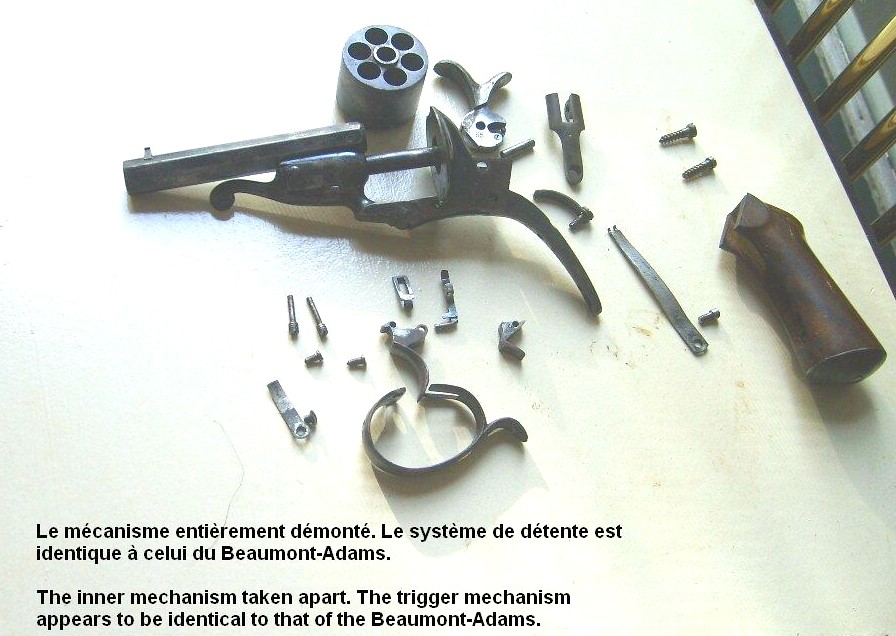
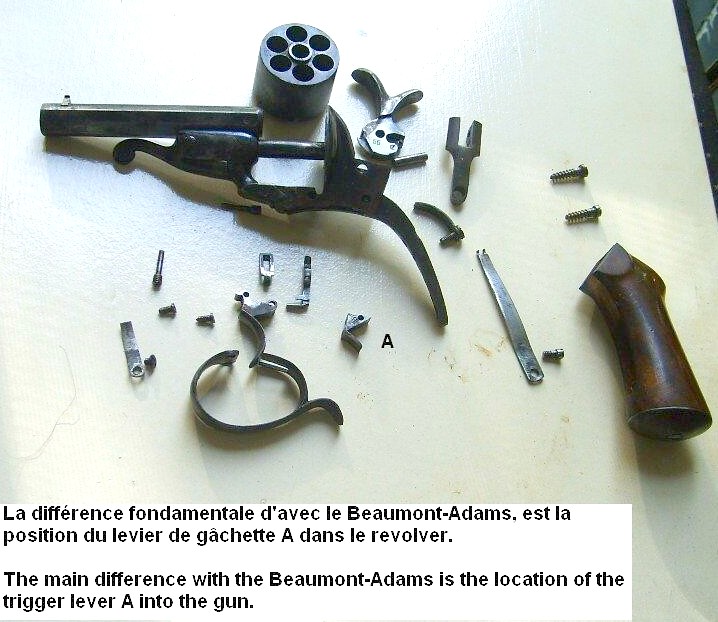
Pictures 6 to 11
SURPRISE
While I had expected a very peculiar mechanism, I am amazed to state that, except for three details, the inner mechanism that lays on my table is...that of the British Beaumont-Adams revolver of 1856!!
Everything is identical, except for the following details:
- The location of the cylinder locking cam, which on the Javelle is a square pin in the middle of the front face of the pawl
- The location of the trigger lever underneath the hammer instead of above it
- The curious trigger return spring.
Note
On Feb. 20th, 1856, the British lieutenant Frederick Beaumont of the Royal Engineers was granted a London patent covering improvements allowing the Adams revolvers to be used either in single or double action mode. So far, the excellent Adams revolvers were double-action only, what lead their challengers to underline their lack of accuracy.
On June 3rd, 1856, Beaumont was granted an US patent for the same improvements under number 15.032.
The Beaumont system proved of huge impact on the market, since it would allow Robert Adams to regain the confidence of the British public and would force Samuel Colt to close his London factory due to a vertiginous drop of sales. With its perfect finish, its solid frame, the Beaumont system and the new ramrod patented by Kerr, the Beaumont-Adams revolver proves much superior to the Colt Navy 1851, however more delicate.
On basis of the US patent, the Massachusetts Arms Company was licensed to manufacture about 19,000 specimens of the gun, of which about 1,750 were purchased by the Union Army at the beginning of the American Civil War.
The Beaumont-Adams revolver was probably Sam Colt's most important commercial failure on his entire career.
So it looks like our friend Javelle, who had not applied for a patent until 1861, had found inspiration in the Beaumont system patented six years earlier. Though he would bring some personal improvements to the original mechanism.
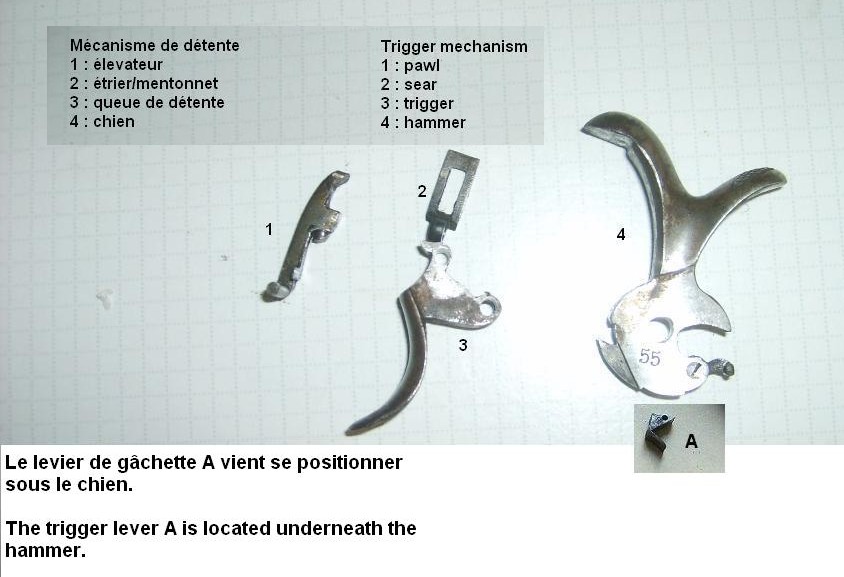
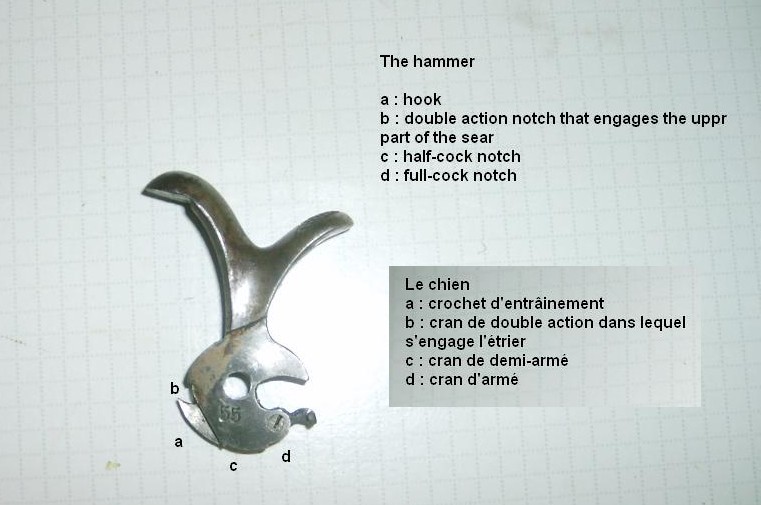
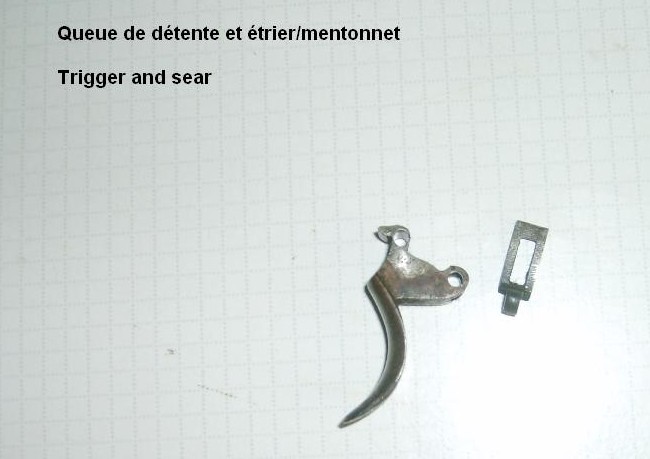
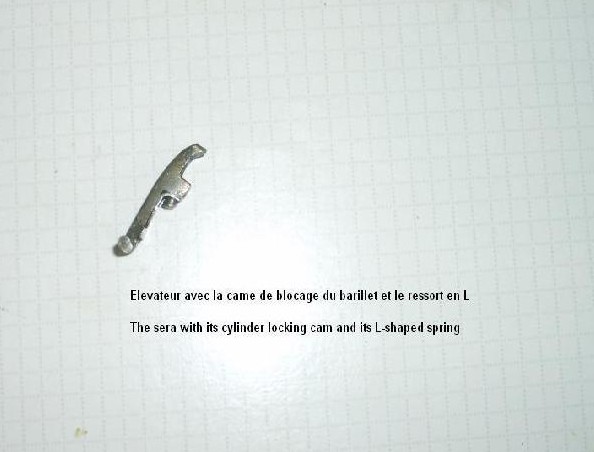
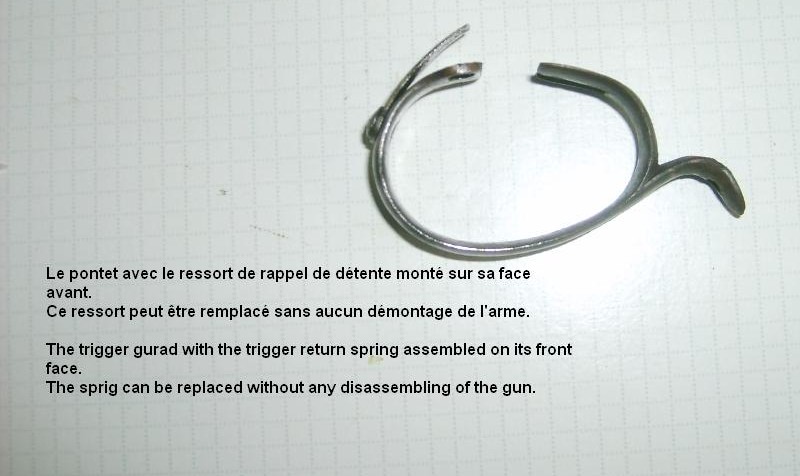
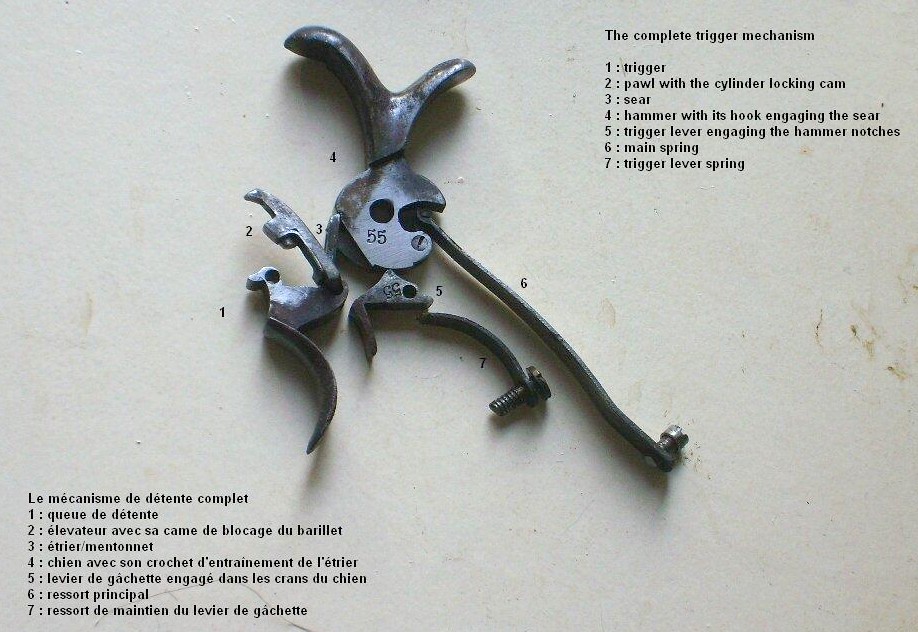
WORKING (pictures 11 to 13) compared to the Beaumont-Adams
The system invented by Beaumont and likely copied by Javelle works as follows:
On top of the trigger block are two parts mounted on a common axis: the pawl and a rectangular flat frame of which the upper edge is bevelled. The front face of the hammer has an upwards oriented hook that engages the "window" in the flat frame. That rectangular frame has the same function as the classical sear found in almost all double-action revolvers.
The pawl has an L-shaped flat spring that forces it forward towards the ratchet teeth, while the bottom part pushes the sear backwards against the hammer. Also, the Javelle pawl has in the middle of its front part a raised portion that engages the ratchet teeth when in upper position and acts as a locking cam. A similar system is found on the British (another one!) Daw revolvers of the 1850's, but not on the Adams, which features a more classical locking cam located on the upper part of the trigger block.
Two notches (half and fullcock) are cut in the bottom part of the hammer, that engage the upper part of the trigger lever. The trigger lever is held up by the short curvy flat spring that is attached to the frame under the main spring. The bottom part of that trigger lever is the rear trigger that is visible in the guard outside the frame.
When the hammer is thumb-cocked, the hammer hook engages the sear and pulls it upwards; at the bottom part, the trigger lever engages the fullcock notch, holding the hammer in position.
When the trigger is squeezed a little more, it pushes back the rear trigger that causes the trigger lever to disengage the fullcock notch so that the hammer can fall freely to strike. That is the single-action mode.
In the double-action mode, the squeezed trigger pushes the sear upwards so that its upper edge engages a notch cut in the front face of the hammer above the hook.
The motion pushes the hammer backwards; at the end of the movement, the trigger pushes back the rear trigger so that it can't lock the hammer, while the angle opening causes the upper edge of the sear to slide out of the notch at the front part of the hammer, allowing the latter to fall and strike.
Javelle has added a half-cocked notch that holds the hammer halfway and is an additional safety while replacing the cylinder home after loading. The user can release the hammer and let is rest between two chambers by pressing the rear trigger only.
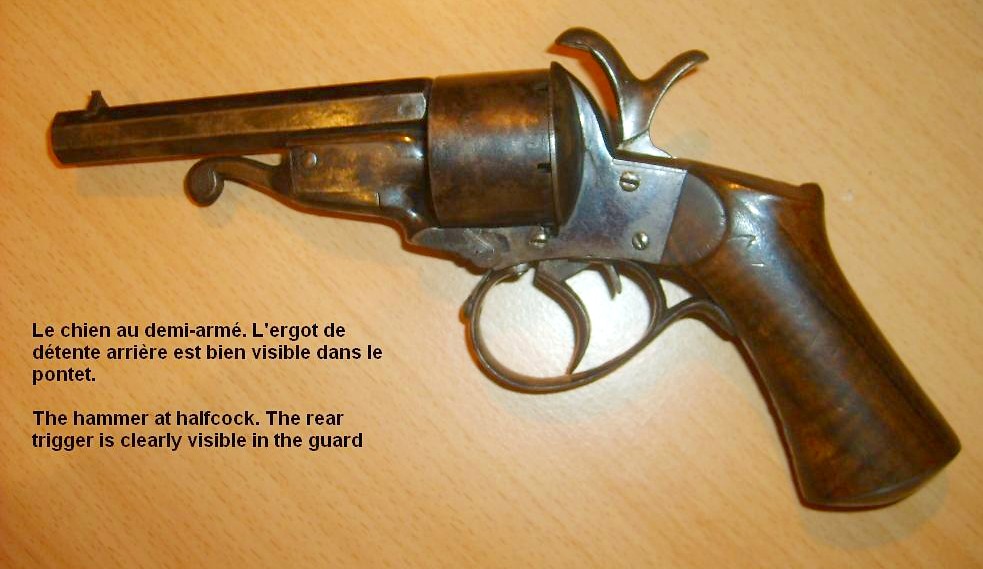
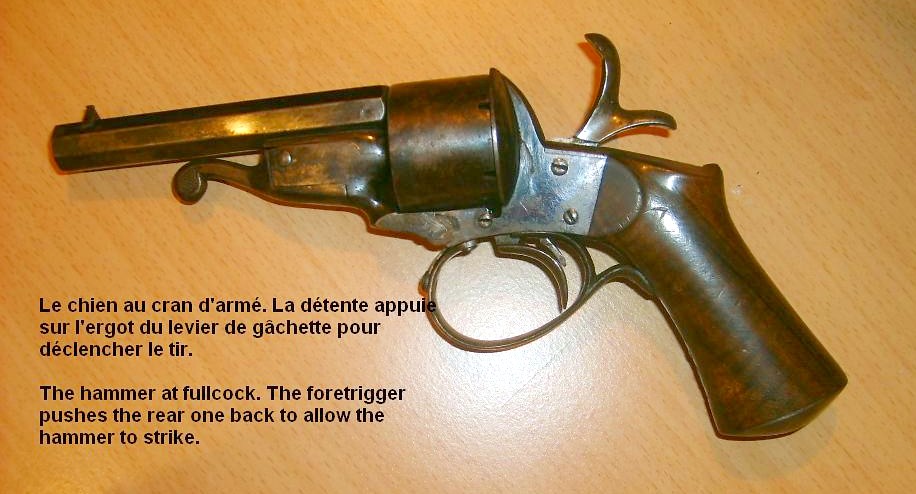
Pictures 14 and 15
On the Beaumont-Adams revolver, the trigger lever is a small flat part mounted in the upper part of the frame in front of the hammer and held down by a small flat spring.
That flat piece engages two notches cut in the upper part of the hammer body, and has the same effect as Javelle's "rear trigger". In the single-action mode, the upper part of the sear pushes the trigger lever upwards, which allows the hammer to strike. For the rest, the lock works the very same way as exposed herefore.
From the point of view of a modern amateur, I would say that the Javelle trigger lever is more reliable and less subject to wear as the Beaumont one. One can also compare both mechanisms to the renown "triple action" made by Lefaucheux, in fact not very different in the basic principle.
Javelle has also innovated with his trigger return spring, which is a simple straight flat spring, attached by a screw at the front part of the guard. The most important advantage of that spring compared to the classical V springs located in a cavity under the cylinder, is that it is very easy to make and can be mounted in place without having to disassemble anything else. The spring simply engages the front part of the trigger block and bends against the trigger guard.
In conclusion, the Javelle revolver is an interesting illustration of the continuuous seeks for improvements, the frequent divagations and the regardless copy of other inventions by gunsmiths of an era where in the industry everything was still possible.
Obviously inspirited by the most renown European gunmakers of the time (Lefaucheux for the locking lever and the pinfire ammo, Beaumont-Adams for the trigger mechanism, Webley for the topbreak barrel principle), Javelle has still given his guns a remarkable personal touch.
Although its complexity made it uninteresting to the military, the Javelle revolver may be considered a high quality weapon, reliable and perfectly finished in all details.
The 9 mm and 12 mm calibers give it a stopping power comparable to that of the most military and police guns of its time.
Its obsolete charm and the relative scarceness make it a desirable collector's item.
Marcel